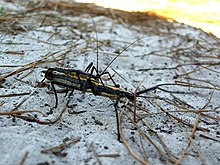Anisomorpha
| Anisomorpha | |
|---|---|

| |
| Scientific classification | |
| Domain: | Eukaryota |
| Kingdom: | Animalia |
| Phylum: | Arthropoda |
| Class: | Insecta |
| Order: | Phasmatodea |
| Family: | Pseudophasmatidae |
| Subfamily: | Pseudophasmatinae |
| Tribe: | Anisomorphini |
| Genus: | Anisomorpha Gray, 1835 |
| Type species | |
| Phasma buprestoides | |
| Species | |
| |


Anisomorpha is a genus of walking stick insect capable of secreting a substance from glands on the metathorax that can cause an intense burning irritation of the eyes and mouth of potential predators on contact. In some cases, this causes temporary blindness. Species are found throughout the mainland Central, northern South America, and the southeastern United States. The adult female is larger than the male in length and width. There are currently four accepted species in this genus, and all are wingless.[1][2][3][4]
References[edit]
- ^ "Anisomorpha Report". Integrated Taxonomic Information System. Retrieved 2019-03-22.
- ^ "Anisomorpha". GBIF. Retrieved 2019-03-22.
- ^ "Anisomorpha Genus Information". bugguide.net. Retrieved 2019-03-22.
- ^ Brock, Paul D.; Otte, Daniel (2018). "Phasmida species file online, Version 5.0". Retrieved 2019-03-22.
Further reading[edit]
- Arment, Chad (2006). Stick Insects of the Continental United States and Canada. Coachwhip Publications.
External links[edit]
- Phasmid Study Group: Anisomorpha
- Pubs.rsc.org
- Pubs.acs.org
- Springerlink.com
- Pubs.acs.org (2)
- Iospress.metapress.com
- Anisomorpha buprestoides, twostriped walkingstick on the UF / IFAS Featured Creatures Web site
 Data related to Anisomorpha at Wikispecies
Data related to Anisomorpha at Wikispecies
